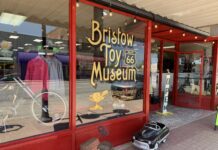One of the things I’ve long admired about northeastern Oklahoma resident Junior Brown is the way his affinity for the country music and western-swing performers of an earlier era colors everything he does but doesn’t make him sound like a “retro” act. As was the case with one of his big influences, western-swing giant Bob Wills, Brown has been able to stir together a vast array of musical ingredients and come up with an appealing and unusual contemporary dish that’s all his own.
He’ll be the first to admit, however, that it took him a while.
“There were certain songs I’d do, or write, and there’d be no other way to sing them than like Ernest Tubb,” he says. “Then, when I’d do shuffles, it’d be Ray Price. For years and years, decades and decades, when I worked in the dance clubs, I’d play those shuffles, and the Ray Price style was a big part of that. I had a low voice, so when I kind of put the vibrato to it, I sounded like Ray Price. And maybe I’d try to imitate Merle Haggard a little bit, too.
“I was always searching, you know?” he adds. “And then (famed steel-guitarist) Lloyd Green told me, ‘You’ve got to cut the umbilical cord.’ That’s one of his famous sayings: ‘Cut the umbilical cord and be your own influence.’ Influences are great to get you started, but it’s like jump-starting a car. You’ve got to take those jumper cables off and let the car run on its own. That’s when I started finding my own sound, taking all these influences like Lloyd Green and Leon McAuliffe and Eldon Shamblin, and combining them into something that I could call a style of my own – almost like a meat grinder making ground-up hash.”
He laughs. “But when you get everything in there that you want, you’re not imitating any more. You’ve become your own thing.”
An Arizona native, Brown bounced around several states as a child, discovering country music when the family moved to Indiana. His country-music career began in the clubs of Albuquerque, N.M., while he was still in his teens.
In the mid-1980s, he was playing “somewhere in Oklahoma, as a sideman with somebody,” he recalls, when a young woman came up to him and told him about the Hank Thompson School of Country Music, on the campus of what is now Rogers State University in Claremore. A noble experiment in music-business and performance education, its roster of notable instructors included the aforementioned Shamblin and McAuliffe, who was then the director. Both men were former Bob Wills sidemen and shining stars in the western-swing firmament.
“When she named those two guys and said they were up there teaching, I thought, ‘Man, what kind of college is this?’” he says, laughing again. “It sounded like a pretty swingin’ campus.”
Intrigued, he traveled to Claremore to check things out, ending up as an instructor. Although he got hired during the waning days of the school, he was there long enough to meet and marry a talented student, Tanya Rae, who’s been his rhythm guitarist and wife ever since.
Brown’s big break as a recording artist came a few years later, when he signed with Curb Records in Nashville, which released his first solo disc, 1990’s 12 Shades of Brown.
“I had the same old broken-heart story of knocking on all the doors in Nashville, and ‘thanks, but no thanks,’” he remembers. “There’ve been countless stories like that, and I was no exception. So when I did have some success, it just felt so good, and I made the most of it. I hung out with the cats I wanted to, did a video with George Jones, worked with Hank Thompson, whatever I could do to make every moment count. I did TV shows with (Johnny) Paycheck. I just really enjoyed all that, because I knew it was coming to an end. I knew those people were getting old. I thought, ‘Enjoy it while you can, because this is the end of an era.’
“I’ve always been that way,” he adds. “I’ve always looked to the past for inspiration, and not just as inspiration for the music, but also as a way to live life. You learn from old people. I always have. I’ve always tried to think progressively like a young person, but to learn the wisdom of the old people. That’s why you hear a lot of that in my music – because I hung out with those old cats.”
Of course, the way artists get music to audiences has changed drastically since Brown signed his first record deal. While the goal of going out and getting a recording contract is still a career model for some performers, it’s far from the only one. Technology and social media have radically changed the way music is delivered, and while Brown is quick to say that Tanya Rae is the computer user in their family, he also acknowledges the importance of the internet – especially for his brand-new disc Volume 10, the first CD he’s put out on his own.
“You know, the record business now is more about someone in a room with a computer doing all your promotion and everything,” he says. “It’s a new ballgame, and the whole problem is, how do you promote your record in this new world?
“I think the way you do it is the way I solve other problems – by looking back to see how the old-timers would’ve done it. Well, they did it fan by fan, handshake by handshake, autograph by autograph, concert by concert, ticket by ticket, album by album. It’s just all about the fans and connecting with them any way you can on a grassroots level.
“This new record of mine is sort of catching on out there, and I really appreciate it, because I don’t have a sophisticated PR team. I have my webmaster, Matt Raney, and he helps a lot.”
Releasing one of the best discs of his career doesn’t hurt his chances, either. Although its six songs make it more of an EP (that’s extended-play as opposed to long-play, or LP, both old terms for vinyl records), it contains songs that show off his penchant for wry and unusual wordplay as well as his prowess on vocals and the guit-steel, an instrument of his own invention that combines electric and steel guitars, two longtime staples of country music. The lone cover song on the CD is an inventive and satisfying version of “Almost to Tulsa,” an instrumental written by one of his heroes, former Ernest Tubb steel player Buddy Charlton, while originals like “Hang up and Drive” and “Phantom of the Opry” combine classic-country grooves with up-to-the-minute lyrics.
“I guess that’s my way of being modern,” Brown says. “Sometimes, a guy puts a record out and you go, ‘Oh. Wow. When did that come out? That’s really authentic. Sounds like you did that in 1968 or something.’ But that’s a whole other thing. That’s for other people. I want to be modern. I want to be 21st century.”
He laughs again. “I want to be relevant. I might still play like a hillbilly, but I’m writing lyrics about how I feel about all these gadgets and things that are a part of this modern technology, and that tells you it’s a new song.”
Volume 10 is available from CD Baby and other internet outlets as well as, appropriately, the Ernest Tubb Record Shop in Nashville.






















